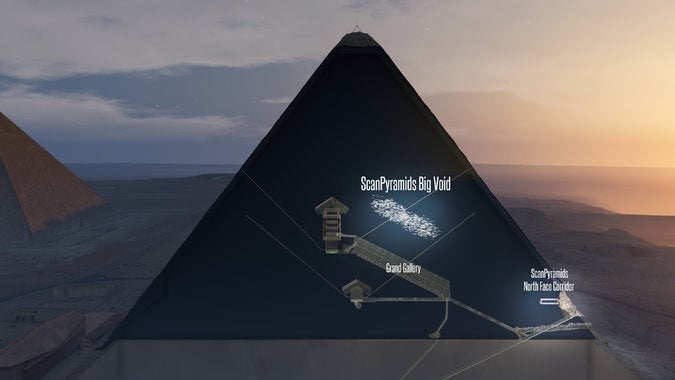What we know about the mysterious chamber discovered inside the Great Pyramid
We are one step closer to understanding more about the only remaining Wonder of the Ancient World.


We are one step closer to understanding more about the only remaining Wonder of the Ancient World.
Scientists have discovered a void inside the Great Pyramid of Giza, according to new research published in the scientific journal Nature. The discovery is the result of work from ScanPyramids, an organization led by the HIP Institute and the Faculty of Engineering at Cairo University that is dedicated to studying the Pyramids of Egypt using non-invasive techniques.
A symbol of the awesome power of ancient Egypt, the Great Pyramid is 479 feet tall, the tallest structure built by man until the Eiffel Tower in 1889. Built as a royal tomb around 2560 BC, it’s made of an estimated 2.3 million blocks of stone.
There were three known chambers inside the Great Pyramid—an unfinished low chamber near the bedrock, as well as the king and queen’s chambers, believed to be for Pharaoh Khufu and his wives—until today.
What is the secret chamber?
According to Nature, the large, previously unknown “big void” inside the Great Pyramid is the first major interior structure found there in well over a century.
Though they don’t know the precise dimensions, researchers say the hidden chamber is at least 100 feet long and located above a hallway about 155 feet long, known as the Grand Gallery, part of a maze of passages inside the pyramid.
“What we are sure about is that this big void is there, that it is impressive, that it was not expected by, as far as I know, any kind of theory,” Mehdi Tayoubi, president and co-founder of the HIP Institute told Reuters.
How was the chamber found?
Researches made the discovery using cosmic ray-based imaging, a process that uses modern particle physics to understand new information about ancient structures.
Known as muon tomography, the technique generates 3-D images using information from particles that hit the Earth close to the speed of light and then penetrate deeply into solid objects. Muons (elementary particles similar to electrons) originate from collisions between cosmic rays and atoms in the upper atmosphere. They penetrate material more deeply than X-rays, so the technique can be used to image more dense structures than, say, CT scanning.

Muons can penetrate stone, but as they travel through a dense object they lose energy and decay, so scientists can understand the density of an object based on the number of muons flowing from a particular direction. If there’s a big void, lots of muons will flow through.
Muon detection has improved significantly since it was developed in the 1960s, so Tayoubi and his colleagues were able to use three advanced muon-detection techniques–nuclear-emulsion films, hodoscopes, and ardon gas-based detection. Every method showed the same result: a large void in the area above the Grand Gallery.
The mysteries that remain
Experts are unsure about the purpose of the void—it could have been a burial chamber, another gallery, an architectural anomaly, or simply a sealed-off construction passage. However, some historians are more excited than others about the discovery.
“It’s very clear what they found as a void doesn’t mean anything at all. There are many voids in the pyramid because of construction reasons,” said Zahi Hawass, an Egyptologist and former Egyptian minister of antiquities and director of excavations at Giza, Saqqara, Bahariya Oasis and the Valley of the Kings, told LiveScience.
Tayoubi argues that the void is not a construction irregularity because blocks of varying sizes and shapes would have absorbed more muons that were detected.
Right now, there are no plans to enter the Great Pyramid to further investigate the void, because there is no way to get to it through the existing network of passages and chambers. Egyptologists banned the use of destructive methods to study the pyramids. However scientists could put additional muon detectors in the king’s chamber to try and assess the void from alternate angles.
Given the world’s fascination with the pyramids and secrets of the ancient world, it’s clear the discovery will lead to much archaeological speculation and debate.
Hany Helal of Cairo University, coordinator of the ScanPyramids project, put the open question to the academic community: “We open the question to Egyptologists and archaeologists: what could it be?”